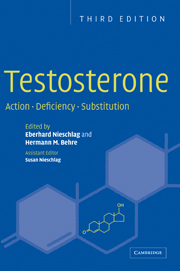Book contents
- Frontmatter
- Contents
- List of contributors
- Preface
- 1 Testosterone: an overview of biosynthesis, transport, metabolism and non-genomic actions
- 2 The androgen receptor: molecular biology
- 3 Androgen receptor: pathophysiology
- 4 Behavioural correlates of testosterone
- 5 The role of testosterone in spermatogenesis
- 6 Androgens and hair: a biological paradox
- 7 Androgens and bone metabolism
- 8 Testosterone effects on the skeletal muscle
- 9 Androgens and erythropoiesis
- 10 Testosterone and cardiovascular diseases
- 11 Testosterone and erection
- 12 Testosterone and the prostate
- 13 Clinical uses of testosterone in hypogonadism and other conditions
- 14 Pharmacology of testosterone preparations
- 15 Androgen therapy in non-gonadal disease
- 16 Androgens in male senescence
- 17 The pathobiology of androgens in women
- 18 Clinical use of 5α-reductase inhibitors
- 19 Dehydroepiandrosterone (DHEA) and androstenedione
- 20 Selective androgen receptor modulators (SARMs)
- 21 Methodology for measuring testosterone, DHT and SHBG in a clinical setting
- 22 Synthesis and pharmacological profiling of new orally active steroidal androgens
- 23 Hormonal male contraception: the essential role of testosterone
- 24 Abuse of androgens and detection of illegal use
- Subject Index
10 - Testosterone and cardiovascular diseases
Published online by Cambridge University Press: 18 January 2010
- Frontmatter
- Contents
- List of contributors
- Preface
- 1 Testosterone: an overview of biosynthesis, transport, metabolism and non-genomic actions
- 2 The androgen receptor: molecular biology
- 3 Androgen receptor: pathophysiology
- 4 Behavioural correlates of testosterone
- 5 The role of testosterone in spermatogenesis
- 6 Androgens and hair: a biological paradox
- 7 Androgens and bone metabolism
- 8 Testosterone effects on the skeletal muscle
- 9 Androgens and erythropoiesis
- 10 Testosterone and cardiovascular diseases
- 11 Testosterone and erection
- 12 Testosterone and the prostate
- 13 Clinical uses of testosterone in hypogonadism and other conditions
- 14 Pharmacology of testosterone preparations
- 15 Androgen therapy in non-gonadal disease
- 16 Androgens in male senescence
- 17 The pathobiology of androgens in women
- 18 Clinical use of 5α-reductase inhibitors
- 19 Dehydroepiandrosterone (DHEA) and androstenedione
- 20 Selective androgen receptor modulators (SARMs)
- 21 Methodology for measuring testosterone, DHT and SHBG in a clinical setting
- 22 Synthesis and pharmacological profiling of new orally active steroidal androgens
- 23 Hormonal male contraception: the essential role of testosterone
- 24 Abuse of androgens and detection of illegal use
- Subject Index
Summary
Introduction
In industrialized countries, the average life expectancy is some eight years less in males than in females. Since cardiovascular disease is the most frequent cause of death and male gender is one of the classic risk factors for premature coronary artery disease (threefold excess in men before the age of 55 years), stroke (up to twofold excess in men), peripheral vascular disease (two to threefold excess in men) and heart failure, the lack of estrogens and the abundance of androgens have often been regarded as the proximate cause underlying this male disadvantage. Sex hormones may play a role in cardiovascular morbidity and mortality by modulating the risk factors of atherosclerosis and vascular function, by influencing the progression of subclincial coronary, cerebral and peripheral arterial vessel wall lesions to symptomatic cardiovascular disease including myocardial infarction, stroke, claudicatio intermittens and erectile dysfunction. Finally, sex hormones may influence the long-term clinical sequelae of coronary artery disease such as heart failure and arrhythmias.
The lack of an inflection point in the rate of increase in cardiovascular morbidity and mortality after menopause and the failure of controlled combined estrogenprogestin replacement intervention trials to show prevention of coronary events in postmenopausal women (Manson et al. 2003; Roussow et al. 2002) have shed doubts on the cardioprotective role of estrogens and increased the interest in testosterone. With the prospects of much wider therapeutic applications of testosterone for contraception, treatment of patients with aplastic anaemia, sarcopenic, osteopenic and dysphoric states, as well as physiological ageing, it has become increasingly important to address whether testosterone treatment might increase the risk or severity of cardiovascular diseases.
- Type
- Chapter
- Information
- TestosteroneAction, Deficiency, Substitution, pp. 297 - 332Publisher: Cambridge University PressPrint publication year: 2004
- 7
- Cited by

